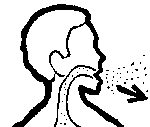

 Tuberculosis (often abbreviated as TB) is an infectious disease that commonly attacks the lungs, but can attack almost any part of the body. Common sites for Tuberculosis to attack include the lungs, the lymph nodes, the spine,and the kidney. Over a century ago, in 1882, Dr. Robert Koch identified an organism called Mycobacterium Tuberculosis (which is also sometimes referred to as tubercle bacilli) as the causative agent of tuberculosis. Follow this link to see some of the important properties of the M. tuberculosis bacteria.
Tuberculosis (often abbreviated as TB) is an infectious disease that commonly attacks the lungs, but can attack almost any part of the body. Common sites for Tuberculosis to attack include the lungs, the lymph nodes, the spine,and the kidney. Over a century ago, in 1882, Dr. Robert Koch identified an organism called Mycobacterium Tuberculosis (which is also sometimes referred to as tubercle bacilli) as the causative agent of tuberculosis. Follow this link to see some of the important properties of the M. tuberculosis bacteria.
In the United States, tuberculosis is almost exclusively a human disease. However, in many developing countries, cows infected with Mycobacterium bovis constitute a reservoir for the human disease. Unless pasteurized, cows' milk can spread M. bovis, causing gatrointestinal tuberculosis in humans.
Approximately two billion people, which is more than one-third of the world's total population, are currently infected with the tuberculosis bacterium; this includes approximately ten to fifteen million people in the United States alone. TB is the world's leading cause of death from a single infectious organism, killing more adults every year than AIDS, malaria and tropical diseases combined. The World Health Organization (WHO) estimates that each year, more than thirty million people become infected with the M. tuberculosis bacterium. This colossal number is equivalent to a new person being infected by TB every second of the day!
 Return to Table of Contents.
Return to Table of Contents. Tuberculosis is spread from person to person through respiratory aerosol. When people with TB in their lungs or throat cough, sneeze, sing, or even talk, the bacterium that causes TB (M. tuberculosis) may be spread into the air. If another person breathes in these bacteria there is a chance that they will become infected with tuberculosis. TB is usually spread by those people who have TB in the lungs or throat by the mechanism described above. However, TB in other parts of the body, such as the kidney or spine is usually not infectious. It is unlikely that one will get TB from a one time incident with someone coughing in a street, restaurant, subway, etc. Also, TB is not spread by dishes,drinking glasses, or clothing. People who have the TB disease are most likely to spread it to people with whom they have daily contact, because it generally takes prolonged exposure to the bacteria before infection occurs.
Tuberculosis is spread from person to person through respiratory aerosol. When people with TB in their lungs or throat cough, sneeze, sing, or even talk, the bacterium that causes TB (M. tuberculosis) may be spread into the air. If another person breathes in these bacteria there is a chance that they will become infected with tuberculosis. TB is usually spread by those people who have TB in the lungs or throat by the mechanism described above. However, TB in other parts of the body, such as the kidney or spine is usually not infectious. It is unlikely that one will get TB from a one time incident with someone coughing in a street, restaurant, subway, etc. Also, TB is not spread by dishes,drinking glasses, or clothing. People who have the TB disease are most likely to spread it to people with whom they have daily contact, because it generally takes prolonged exposure to the bacteria before infection occurs.
 Return to Table of Contents.
Return to Table of Contents.It is important to understand that there is a difference between being infected with TB and having TB disease. Someone who is infected with TB has usually become infected by breathing in M. tuberculosis bacteria. In those individuals who are infected with TB, their body is usually able to fight the bacteria and prevent it from growing, leaving it in an "inactive" state. Most people who become infected with the TB bacteria do not get sick because their immune systems are able to isolate the bacteria in the cells lining the lungs' air sacs. Thus, once in the lungs, the bacteria grow and eventually are surrounded by lymphocytes, macrophages, and connective tissue in a hypersensitivity response that forms small, hard nodules called tubercules. In other words, the human immune system builds a wall around the TB bacteria, inside of which they can remain alive for many years. While the TB bacteria are "inactive," they cannot do any damage, and they cannot spread to other people.
Many people who have TB infection never develop TB disease. In these people, the TB bacteria remain "inactive" for a lifetime without causing disease. It should be noted, however, that while the TB bacteria can remain alive in the body for several years, they can just as easily become reactivated later on in life if the body's defenses are ever weakened. Millions of Americans have TB infection and are usually not even aware of it.
People with TB infection:
 Return to Table of Contents.
Return to Table of Contents.TB disease is a serious illness caused by "active" TB bacteria. There are two possible ways a person can become sick with TB disease. The first applies to a person who may have been infected with TB for years and has been perfectly healthy because their immune system has been able to keep the TB bacteria in an "inactive" state. The time may come when this person suffers a change in health. The cause of this change of health may be due to a variety of things, including:
When the body's defenses are weakened and it's ability to protect itself is damaged, the TB infection can become TB disease. The transition from TB infection to TB disease occurs by the "inactive" TB bacteria becoming "active". This happens when TB bacteria break out of the walls that the immune system had previously bound them in, begin multiplying and damage the lungs or other organs.
Another way the TB bacteria can go from "inactive to "active" is:
People with TB disease can have any or all of the following symptoms:
 Return to Table of Contents.
Return to Table of Contents. What are the Methods of Detecting TB?
There are a number of different ways of determining if one has TB Infection or Disease:
 Return to Table of Contents.
Return to Table of Contents.
 Return to Table of Contents.
Return to Table of Contents.Anyone can get TB regardless of race, age, sex, and financial status. However, there are certain groups that are at a higher risk to get active TB disease than others. These groups include:
 Return to Table of Contents.
Return to Table of Contents. What are the Current Treatments for TB?
Physical and mental rest, nutritional buildup and various forms of collapse therapy were used in the past but have been replaced by specific chemotherapy.
The most widely used anti-tuberculosis drugs at present are:
Multiple-drug therapy is often used to prevent the emergence of drug-resistant mutants. Isoniazid (isonicotinic acid hydrazide, INH), a bactericidal drug is most often used for the treatment. Rifampin or ethambutol (or both) is frequently combined with isoniazid. Therapy is usually given for 6-9 months, but the patient's sputum becomes noninfectious within 2-3 weeks. After this time, the patient is no longer infectious and cannot spread to other people. The necessity for the extended therapy is attributed to:
Resistance to isoniazid and other anti-tuberculosis drugs is being seen with increasing frequency in the United States.
 Return to Table of Contents.
Return to Table of Contents. What are the Side Effects of Drugs for TB?
 Medicine for TB is relatively safe, however occasionally the drugs may cause side effects. The side effects can range from minor problems to more serious problems.
Medicine for TB is relatively safe, however occasionally the drugs may cause side effects. The side effects can range from minor problems to more serious problems.
The side effects listed below are serious. If one has any of the following symptoms, one should contact their physician immediately.
The side effects listed below are some of the more minor side effects caused by drugs used to combat TB:
 Return to Table of Contents.
Return to Table of Contents. What is Multi-Drug Resistant TB?
When TB patients do not take their medicine as prescribed, the TB bacteria can become resistant to a certain drug and consequently the drug can no longer be used to kill the bacteria. Drug resistance is most common in people who:
Also, the TB bacteria can become resistant to more than one drug. This is called multi-drug resistant TB (MDR TB) and is an extremely serious problem that is currently treated with other drugs which cause significantly more side effects. In addition, people who have spent a lot of time with someone who has MDR TB can become infected with TB that is resistant to several drugs.
Follow this link for a list of articles on multi-drug resistant tuberculosis.
 Return to Table of Contents.
Return to Table of Contents.The only TB vaccine currently available, the bacillus Calmette-Guerin (BCG) vaccine, is given to infants in areas of the world where TB is most common as part of the immunization program recommended by the World Health Organization. Made from a live, but weakened cousin of the TB bacterium, BCG prevents the spread of TB infection within the body but does not prevent initial infection. The effectiveness of BCG in adults has varied widely in large-scale studies. In addition, persons immunized with BCG often have a positive reaction to the tuberculin skin test, thus diminishing the usefulness of this valuable diagnostic tool. Because of BCG's limitations, more effective vaccines are needed.
Follow this link for more information on the development of a 'new' TB Vaccine.
 Return to Table of Contents.
Return to Table of Contents.There are a number of ideas that have already been implemented for the future prevention and control of TB. Some of them are listed below.
 Return to Table of Contents.
Return to Table of Contents. Gallery of Images relating to Tuberculosis.
| Below are a number of Images of the results of Tuberculosis and of the bacterium M. tuberculosis: |
|---|
Click here to see an image of Tuberculosis in the Lung forming a giant Langhan's cell. |
Click here to see an image of a caseating granuloma in the lung caused because of Tuberculosis. |
Click here to see a stained slide containing M. tuberculosis. |
Click here to see a slide containing the beaded form of M. tuberculosis. |
Click here to see an image of a Ghon Complex in the lung formed as a result of Tuberculosis. |
Click here to see an image of cavitary tuberculosis in the lung. |
Click here to see an image of miliary tuberculosis in the lung. |
Click here to see an image of granulomas in the lung (under a low power microscope) formed as a result of tuberculosis. |
Click here to see an image of a granuloma in the lung with caseous necrosis (under a high power microscope) formed as a result of tuberculosis. |
Click here to see an image of a granulomatous endometritis in the lung (under a high power microscope) formed as a result of tuberculosis. |
Click here to see an image of a Ziehl-Neelsen acid fast stain, in which many red rods of M.tuberculosis can be seen. |
Click here to see an image of an Auramine stain with fluorescence microscopy, demonstrating yellow rods of M. tuberculosis. |
 Return to Table of Contents.
Return to Table of Contents. Gopher Resources on Tuberculosis.
 Follow this link to a comprehensive listing of Gopher Sites including information about:
Follow this link to a comprehensive listing of Gopher Sites including information about:
 Return to Table of Contents.
Return to Table of Contents.
 PBS's The People's Plague Online: Tuberculosis in America
PBS's The People's Plague Online: Tuberculosis in America New Jersey Medical School's National Tuberculosis Center
New Jersey Medical School's National Tuberculosis Center World Health Organization Global Tuberculosis Programme (GTB)
World Health Organization Global Tuberculosis Programme (GTB) Stanford Center for Tuberculosis Research
Stanford Center for Tuberculosis Research List of Automated Tuberculosis Protocols
List of Automated Tuberculosis Protocols TB/HIV Research Laboratory at Brown University
TB/HIV Research Laboratory at Brown University  American Society for Microbiology
American Society for Microbiology Center for Disease Control (CDC) Home Page
Center for Disease Control (CDC) Home Page The Institute For Genomic Research (TIGR) Home Page
The Institute For Genomic Research (TIGR) Home Page The National Institutes of Health (NIH) Home Page
The National Institutes of Health (NIH) Home Page Extensive List of Other External Tuberculosis Resources
Extensive List of Other External Tuberculosis Resources Return to Table of Contents.
Return to Table of Contents.
Other Sources of Literature and Information:
For more please information, click on the following:
 On-Line Public Access Catalog (Login as Library)
On-Line Public Access Catalog (Login as Library) MELVYLE (Library database of the UC System) (Identify your terminal)
MELVYLE (Library database of the UC System) (Identify your terminal) CARL (Identify your terminal)
CARL (Identify your terminal) Here is a list of some other books relating to Tuberculosis.
Here is a list of some other books relating to Tuberculosis.
 Return to Table of Contents.
Return to Table of Contents.
This page was created by Shivanand (Nandan) P. Lad 
 Return to Table of Contents.
Return to Table of Contents.
Many sources contributed to the text, information, and images in this Web page. They are cited below:
 Return to Table of Contents.
Return to Table of Contents.
The following has been added by the Electronic Desktop Project:
 Contact Us
Contact UsIf you are an educator who is using our NEXTSTEP or virtual applications in the classroom, we would especially like to hear from you. Let us know what you are doing and how it is working out. Continued support for this project will depend on its impact in science education.
If you are an educator who is interested in making use of our NEXTSTEP or virtual applications, please let us know how we can help.
 Return to the Electronic Desktop Project home page
Return to the Electronic Desktop Project home page
![]() Check out the WWW Virtual Application Catalog from the EDP
Check out the WWW Virtual Application Catalog from the EDP
 Check out the NEXTSTEP Application Catalog from the EDP
Check out the NEXTSTEP Application Catalog from the EDP
 Visit the home page for California State University, Los Angeles
Visit the home page for California State University, Los Angeles